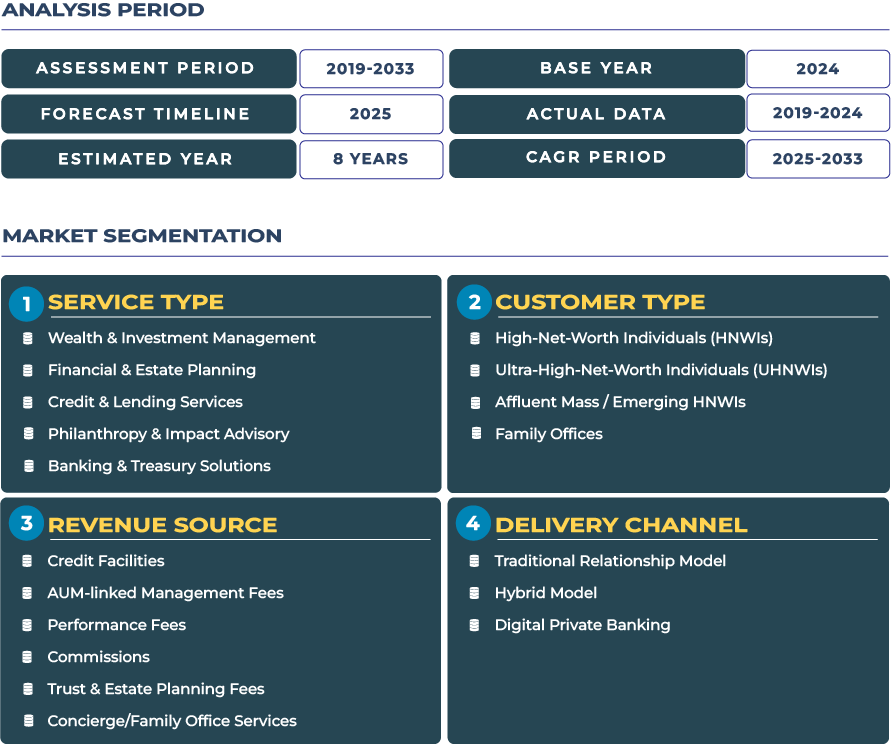Australia Private Banking Market Outlook: Balancing Regulation and Innovation
Australia private banking market exemplifies a carefully calibrated balance between innovation and regulatory rigor. With the sector expected to reach approximately USD 18.4 billion by 2025 and forecasted to grow to around USD 27.5 billion by 2033-implying a CAGR of roughly 5.1% from 2025 to 2033-the environment is shaped by strong financial-regulation frameworks, advanced wealth-tech adoption and a deepening base of high-net-worth individuals (HNWIs).
Note:* The market size refers to the total revenue generated by banks through various services.
In this context, private banking firms are evolving to serve clients not just with investment advice but with integrated platforms that span wealth & investment management, estate planning, bespoke credit/treasury services, philanthropy consulting and digital onboarding. Australia regulatory environment-in which bodies such as the Australian Prudential Regulation Authority (APRA) and Australian Securities & Investments Commission (ASIC) monitor private-wealth governance and risk controls-gives affluent clients confidence that innovation is underpinned by trust and stability. Against this backdrop, private banks are responding to rising demand for wealth solutions tailored to an affluent generation navigating retirement, global mobility, tax optimisation and family-office dynamics. At the same time, the macro-economic context in Australia-moderate GDP growth, resilient housing market, high household wealth and external geopolitical pressures-means private banking firms must deliver both growth and resilience. The challenge lies in scaling digital-wealth models while maintaining the high-touch advisory expected by UHNW clients, and doing so under tighter compliance and transparency regimes.
Growth Engines and Friction Points: What’s Driving and What’s Holding Back Australia Private Banking Market Growth
HNWI Growth, Pension-Fund Dynamics and Regulatory Transparency
The Australian private banking market benefits from a rising affluent cohort driven by business exits, real-estate capital gains and generational wealth transfer. The country’s substantial superannuation (pension) assets and rising retirement-wealth pathways create demand for private-banking services focused on decumulation, tax strategy, legacy planning and inter-generational advisory. Moreover, Australia regulatory transparency and stable institutions strengthen client confidence-an essential factor in private banking where trust underpins adviser-client relationships.
Compliance Cost Burdens, Fee Pressure and Market Concentration
Nonetheless, private banking in Australia must contend with elevated structural costs: compliance regimes, financial-crime risk management, data-privacy regulations and fiduciary expectations add to cost-to-serve. Fee pressure is increasing, particularly as digital-wealth platforms drive commoditisation of advice and clients demand more value for lower cost. Furthermore, market concentration-dominated by a few major banks-can reduce competitive innovation and pose risk of client-service complacency. For private banks to scale profitably, operational efficiency, differentiated service models and client-segmentation sophistication must remain priorities.
Trend-Drivers & Opportunity Windows: Fintech Collaboration, ESG Retirement Solutions and Regional Affluent Penetration in Australia Private Banking Ecosystem
Super-fund Linked Private Banking, ESG Retirement Portfolios and Fintech Collaborations
One notable trend is increasing linkage between private banking and Australia superannuation ecosystem: private banks are designing wealth-solutions targeted at retirees and pre-retirees seeking advisory beyond accumulation-covering estate planning, tax-efficient drawdowns and impact investing. ESG-centric portfolios are also gaining traction, as affluent clients seek alignment of their wealth with sustainability mandates and ethical frameworks. Concurrently, fintech partnerships are accelerating private banks are leveraging digital onboarding, robo-advice, open-banking APIs and embedded wealth modules to reach younger affluent segments and streamline service delivery.
Pension-wealth Advisory, ESG-super Fund Integration, Digital Onboarding For Next-Gen Wealthy
For private banking firms in Australia, key opportunities include developing advisory platforms tailored to the pension wealth lifecycle, targeting affluent retirees and intergenerational wealth transfers. Integrating ESG and impact investing into core private-wealth offerings can also attract values-driven affluent clients seeking responsible investment options. Additionally, leveraging digital onboarding and mobile wealth interfaces enables stronger engagement with next-generation entrepreneurs and younger wealthy households. Firms that pursue these opportunities while upholding regulatory compliance, advisory excellence, and service quality will gain a strong competitive edge in Australia’s private banking market.
Competitive Landscape: Platform-centric Strategies and Ecosystem Alliances in Australia Private Banking Sector
Competition in Australia private banking market is evolving from traditional relationship-advisory models to platform-driven ecosystems. A leading institution, Macquarie Group, known for its wealth-management arm, publicly emphasised expansion into private banking for affluent families and global mobility clients, leveraging its investment-banking heritage and digital capabilities. Private banks are deploying strategic levers including segmentation, client-lifecycle platforms, fintech alliances, and cross-border wealth offerings. The successful firms integrate wealth & investment management, estate & legacy planning, credit & lending services, philanthropy & impact advisory and banking & treasury solutions into unified, technology-enabled client experiences rather than siloed product offerings.







